#Century of Progress
Text


Century of Progress Chicago World's Fair by Weimer Pursell 1933
Source, source
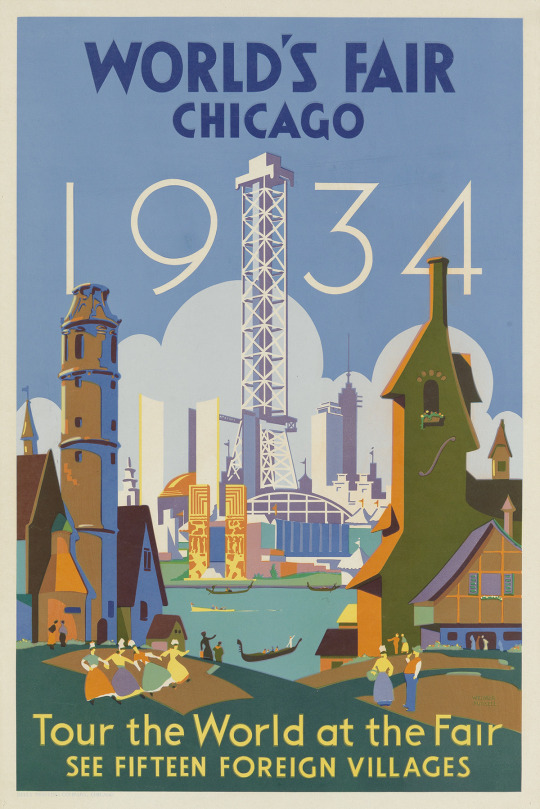
Chicago World's Fair by Weimer Pursell 1934
Source
17 notes
·
View notes
Photo

A Native American demonstrates archery at the Century of Progress International Exposition, the world's fair held in Chicago during the summers of 1933 and 1934. © Century of Progress Records
#1933#1934#1930s#30s#A Century of Progress#Century of Progress#Chicago#Illinois#archery#World's Fair#~
123 notes
·
View notes
Text

A Century of Progress International Exposition opening day ticket. Chicago - 1933.
#vintage illustration#vintage tickets#tickets#chicago#the 30w#the 1930s#international exposition#international expo#world’s fair#worlds fair#chicago world’s fair#1933#a century of progress#a century of progress international exposition#century of progress#art deco#vintage typography#typography
2 notes
·
View notes
Text
youtube
#chicago#balboa#mussolini#roman#ostia#I've been around back at Soldiers Field and missed this#century of progress#1933#Youtube#facism before it was reviled
2 notes
·
View notes
Text


Recent Acquisition - Ephemera Collection
PYROFAX, Complete Gas Service for Gasless Homes.
UCC, Union Carbide and Carbon Corporation. 1934
18 notes
·
View notes
Text

Archosaur Ascendant
15 notes
·
View notes
Text

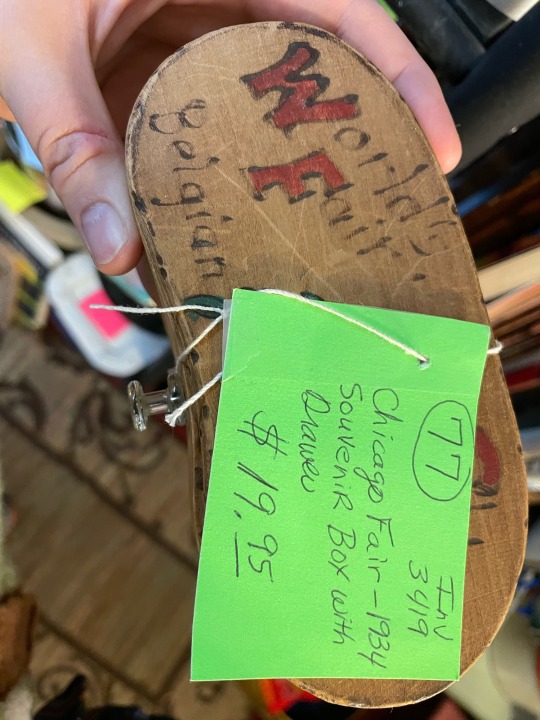
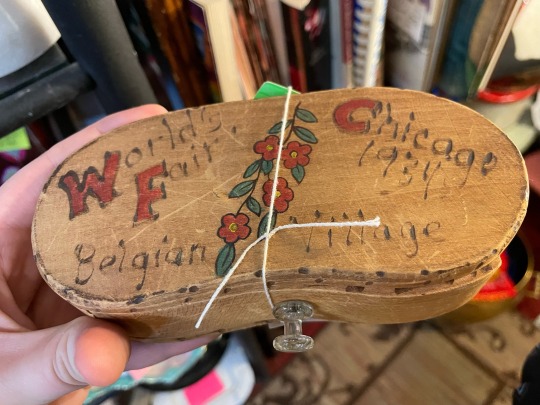
Souvenir Box from the Belgian Village, 1934
I almost overlooked this one until my partner pointed it out to me. This claims to be from the 1933 World's Fair - also known as the Century of Progress International Exposition . Apart from a dysentery outbreak and the the ongoing depression associated with the Great Depression, the Rainbow City they built was a cheerful future outlook in an otherwise bleak time.
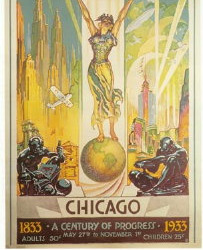


#chicago#1933#1934#belgian village#belgian#souvenir#map#century of progress#world's fair#world fair#chicago world's fair#history#box#vintage
5 notes
·
View notes
Text
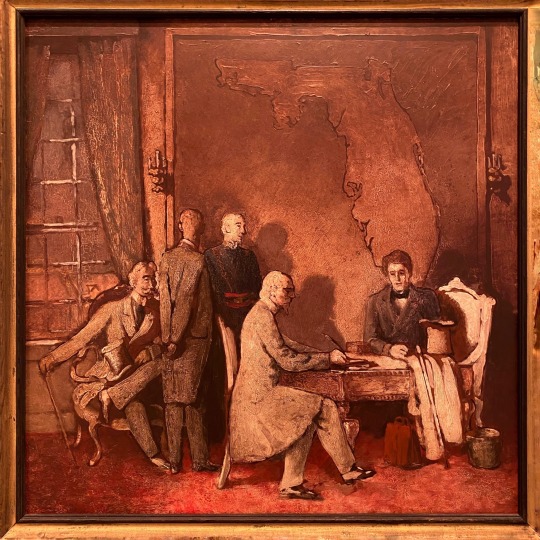


Finding Lost Florida Art at the Chicago Century of Progress, 1933-1934
January 2, 2015 by Fred Frankel
Imagine how you might feel if national icons like John Trumbull’s painting of The Declaration of Independence or Emanuel Leutze’s Washington Crossing the Delaware were lost. On a state level, that’s exactly what happened in Florida. In 1931 the state sponsored an art competition to find six artists to paint large murals depicting important events in the states history for the Florida building at the Chicago Century of Progress. The murals, eventually to be placed in the capitol in Tallahassee,were commissioned, painted, exhibited and then lost. This is the story of those lost paintings and the recent discovery of works submitted for the competition.
It was a difficult time for Floridians: the Florida land boom ended in 1925 when real estate prices crashed; the hurricane of 1926 flattened Miami, and the Depression straight lined tourism.
When the state legislature met in 1931 they wanted to stimulate tourism. They learned that Chicago planned to celebrate the one hundredth anniversary of its incorporation with a World’s Fair: the Chicago Century of Progress. All states were invited. Florida and eleven others, including California and Georgia, decided to participate in a great central quadrangle, the Court of States. Here was a unique chance to tell the country about the Sunshine State.
In 1931 Florida was still a relatively small state with a population of 1.5 million and, with the exception of Osceola and the Seminole Indian Wars, unfamiliar with the national stage. That would change in Chicago. The state would go all out: even minting a small coin that proclaimed: “Florida where summer spends the winter.”
The Florida exhibit included a half acre orange grove, dozens of palm trees, an outdoor garden with wild orchids, a lily pond, and a Seminole village. Inside, the two floored pavilion designed by Phineas Paist, the architect of Coral Gables, featured a Spanish courtyard, its sky crossed by a flight of ibis, dioramas of state industries, the sculpture, Spirit of Florida, by George Ganiere, professor of sculpture at Stetson University, paintings of the sky lines of the larger cities, and six murals, each ten by ten feet, depicting the states’ history.
It all began in September of 1931 when the state legislature authorized a Florida exhibit at the Chicago fair. Governor Doyle Carlton appointed six senators and six representatives to the Florida Century of Progress Commission with Senator W.C. Hodges as chairman,
The commission began a statewide campaign to raise $250,000 for the exhibit and appointed a Florida Century of Progress Jury to find artists of recognized ability to execute paintings of important episodes in Florida’s history. The jury consisted of Mrs. Eve Alsman Fuller, of St. Petersburg, chairman, Mrs. Doyle Carlton, Mrs. Cary Landis, wife of the Attorney General, Senator Hodges, and sculptor C. Adrian Pillars of Jacksonville and Sarasota.
The state of Florida commissioned Pillars for sculptures of Confederate General Kirby Smith and John Gorrie, the inventor of air conditioning, that represent Florida in the United States Capitol Rotunda in Washington, D.C. Pillars’ sculpture, Life, a memorial to Florida’s dead in World War I, stands in Memorial Park in Jacksonville.
Eve Fuller was president of the Florida Federation of Art (FFA) and director of the Florida Art Project (FAP) sponsored by the Federal governments Works Progress Administration (WPA). The FFA, with both amateur and professional artist members, had clubs in almost every major city in the state. During the Depression the FAP put unemployed professional artists back to work.
Mrs. Fuller invited all artists working for the FAP to enter the competition. Members of the FFA were notified and invited to participate. On August 10, 1932 Senator Hodges issued a press release that appeared in newspapers around the state the following day with, “An invitation to all artists who live in Florida or who paint Florida scenes to submit paintings for use in the states exhibit at the World Fair in Chicago next year.”
Paintings were to be submitted in categories: Discovery, Exploration, Christianization, Colonization, Seminole War, and Reconstruction. Artists could enter one painting in each category. The paintings were to be of uniform size, 30 by 30 inches, in simple frames, and signed on the back by the artist.
The jury met at the Ringling Museum of Art in early November 1932. Mrs. Fuller as chairman of the jury expressed pleasure at the interest in the contest by so many of the artists throughout the state and in the character of the work submitted.
Some of the preliminary paintings for the competition have survived and illustrate the mural work done by the winning artists and those awarded honorable mention.
The winning artists were:Addison Burbank for Discovery: Ponce De Leon taking possession of the land for Spain. Burbank was born in California, the son of W. F. Burbank, founder of the Oakland Tribune. In 1926 after art study in Europe he had a solo exhibition of his paintings at the Ferargil Galleries in New York City. Burbank later moved to Miami. The St. Augustine Record, January 13, 1933, quotes Burbank on his visit to St. Augustine, “Through your courtesy Mrs. Burbank and I had the pleasure of visiting the Arts Club (of St. Augustine) Friday evening and viewing the splendid work of yourself and fellow members. We of the Miami Art League envy you your beautiful home and splendid facilities for study and play. St. Augustine is a mine for artists, and we hope the Arts Club will prove the nucleus of a famous art center. Our visit to St. Augustine was in search of material for the mural of Ponce de Leon’s discovery of Florida, for which I received the first award in the state competition held in November. Mrs. Underwood of the Historical Society gave me great help. Mr. Burbank is painting the murals for the Florida exhibits in the Century of Progress Exposition.” Burbank’s mural is lost.
Max Bernd-Cohen for Exploration: DeSoto explores the west coast of Florida. In 1931 Max Bernd-Cohen was one of the first instructors at the Ringling School of Art. Before coming to Sarasota Bernd-Cohen spent two years as a guest lecturer at the Central School of Arts and Crafts in London, England. He taught at the Imperial University, Sapporo, Japan and was chairman of the art department at Florida Southern University in Lakeland. Art lovers from nearby cities attended his popular lectures at the Ringling School, and he was in demand as a speaker throughout the state of Florida. In 1955 he was honored with inclusion, in the Ringling Museum of Art exhibit, Fifty Florida Artists.
Wallace W. Hayn for Christianization: the Spanish building of the first missions in the state. Hayn, like his art, has been lost to history.
Chester J. Tingler for Colonization: Andrew Jackson taking over Florida for the United States. Chester Tingler was an important Miami muralist. Born in Sweden, he grew up in Buffalo, New York where his drawings for the Albright Art Gallery won him a one year art scholarship. After study at the Art Students’ League in New York City, Tingler was employed for some years as scenic and costume designer for Broadway shows produced by Flo Ziegfeld and the Schuberts. In 1917 he received the Gertrude Vanderbilt Whitney award for mural painting. Tingler moved to Miami in 1922 and was later employed by the WPA and the FAP as supervisor of the mural art project for the Miami district. Tingler did murals for the Miami High School library, the Clewiston Airport, Shenandoah Junior High and Ponce de Leon High School. Tingler was named Artist of the Year in 1944-1945 by the Miami Women’s Club and the American Artists Professional League. He was an art instructor with the Terry Art Institute and a regular exhibitor at the Mirell Gallery in Coconut Grove and the Washington Art Galleries of Miami Beach.
Eleanor King was just twenty-three when she painted General Jackson Besieging Media de Luna of San Carlos for the state competition. One of the youngest artists to enter, she did not win, though her painting made the finals, where King lost to Chester Tingler. The Pensacola Journal noted, “Miss King is in receipt of a letter from Mr. Tingler asking her to help him with his painting in the matter of uniforms and accoutrements, both of American and Spanish soldiers. . . . In response . . . the young artist has made it clear that, should she assist in this work, she would expect recognition. She spent many months over her painting, and had the personal assistance of Julian Yonge, authority on Florida history. . . . It was never clear to Pensacola how it could be possible to present Florida historically without giving Pensacola a leading place in portraiture. . . . Is Mr. Tingler to paint a picture of Pensacola’s past? And if he is, will this young artist assist him? Pensacola will learn of this with interest, and every effort should be made to assure that both she and Pensacola are properly recognized in the painting that is to depict the early history of Florida.”
The Pensacola Journal of April 6, 1934, “Eleanor King, young Pensacola artist, is rapidly gaining more than local distinction. This scene was painted in competition for art work to be placed in the Florida exhibit at the Century of Progress Exposition in Chicago and received special mention. Miss King has exhibited in New York at the National Academy, and in Birmingham, Alabama at the annual exhibit of the Southern States Art League, her work attracted much attention….”
Later King married Lawrence Salley and moved to Tallahassee. Mrs. Salley was in New York City in 1939 for the New York World’s Fair. A letter home to her family is quoted in the Pensacola Journal, May 2, 1939, “The Montross Gallery on Fifth Avenue is going to handle my work all the time and plans to open their season in the fall with a one man show of my watercolors, thirty of them.” The Ferrigil Galleries on 57th Street carried her oils, landscapes, and seascapes. King did portraits of many prominent Floridians including historian Caroline Brevard, hung in the school named for her in Tallahassee; a portrait of Chief Justice Fred Davis, hung in the Supreme Court in Tallahassee; and a portrait of William Sheats, who for twenty years, was state superintendent of schools in Florida, hung in the education room of the state capitol.
Mark Dixon Dodd for Seminole War: Osceola driving a knife through the peace treaty at Moultrie Creek. Mark Dodd moved from New York City to St. Petersburg in 1925. He soon became a prominent member of the city’s art community. Dodd opened the Mark Dixon Dodd School of Art on Beach Drive in 1930. In 1936, as his reputation as an artist and teacher grew, Dodd designed and built fifteen homes on Coffee Pot Bayou. In each he placed one of his paintings, usually anchored to the wall above the fireplace. Dodd later became head of the art department at St. Petersburg Junior College.
George Snow Hill for Reconstruction: Governor Bloxham, Hamilton Disston and the Florida Land Sale. George Snow Hill and his artist wife Polly Knipp were two of the most talented artists to work in Florida. Hill was the son of Captain George R. Hill, a longtime resident of St. Petersburg. After graduation from Syracuse University, George and Polly Knipp met, and were married, in Paris. The couple spent several years painting in Europe. On their return home both were acclaimed as among the most brilliant of young American artists, with an invitation to exhibit at the 1932 Olympic International Exhibit in Los Angeles. Competing against 1,100 paintings from thirty-two countries, George Snow Hill won honorable mention for his St. Petersburg, Florida scene, Surf Fishing. Hill worked in the tradition of American muralist Thomas Hart Benton. He should be remembered as one of Florida’s premier muralists, his work evoking and caricaturing the innocence and joy of life in Florida.
Denman Fink, chairman of the Department of Art at the University of Miami, was awarded a commission for “Lunettes” showing the skylines of Florida’s larger cities. Denman Fink made important contributions to art development in Florida. An illustrator and muralist, Fink was head of the art department at the University of Miami for twenty-five years. Fink first came to Miami in 1920 to complete a series of paintings on Florida subjects for a volume of verse by his nephew George E. Merrick. He moved permanently to Miami in 1924, joining Merrick in his development of Coral Gables. With Phineas Paist, Fink helped design plans for the city, its entrances, fountains, plazas’ and the Venetian Pool. In 1938 Fink won a federal competition to paint a large mural for the court house in downtown Miami. The mural, Law Guides Florida Progress, depicts the development of Florida from the days of the Seminoles to the evolution of law. When he died the Miami Herald, June 8, 1956 noted his passing, “Coral Gables is Fink’s Monument. Denman Fink has folded up his easel and laid aside his design board for the last time… the community has lost one of its outstanding citizens.”
Honorable mentions were awarded to Bernd-Cohen, Mark Dodd, Wallace Hayn, Chester Tingler, Emmaline Buchholz, Polly Knipp Hill, and Phillip Schlamp.
Emmaline Buchholz was instrumental in founding the Gainesville Association of Fine Arts in 1923, and in 1927, the Florida Federation of Art. She was the Federation’s first president and the first lady of Florida art. Buchholz remained an important figure in art appreciation and development in Gainesville, and throughout Florida, for many years. Her painting of George Washington, after Gilbert Stuart, hangs in the Florida House of Representatives chamber in Tallahassee.
Polly Knipp Hill was known nationally as one of America’s best etchers. Her etchings were chosen for exhibition in the Fine Prints of the Year, an annual collection which showed the 50 best prints made in America. She depicted, with great success, typical scenes in and around St. Petersburg, fishing from the bridge at Johns Pass, picnicking on the beach, local scenes concerned with people enjoying life in St. Petersburg.
A native of Kentucky, Philip Schlamp moved to Miami in 1926 where he and his wife Ethel were active members of the Miami art community. Ethel Schlamp was co-founder of the Miami Art League. The Miami Herald noted, “A portrait and mural artist, Philip Schlamp spent a good many years… studying historical mural painting, portraiture and sculpture. He is probably best known throughout Florida for an 18 by 10 foot historical mural, depicting Ponce de Leon returning to Spain, to announce the discovery of the land of flowers. The mural was painted for the Florida office of a Chicago firm, and was later shipped to Chicago and hung there….”
When the fair ended in October 1934 it was the beauty of the Florida exhibit, its ability to project the warmth of the state, and the art that stole the show. In the Official Guide Book World’s Fair 1938, Florida was the only state with a photograph of its interior court yard. The Official Guide noted, “Mural paintings of the history of Florida surround the gallery. Osceola, the war chief of the Seminoles, is shown driving his knife through the treaty which would deprive his people of independence.” Florida was one of the few states to use original art to enhance their exhibit. That made a difference.
If you’ve been to a great museum like New York’s Metropolitan, or Sarasota’s Ringling, you can imagine what we’ve lost. Six canvases, huge by today’s standard and, from what we’ve seen of the preliminary painting—beautiful–rivaling the work of John Trumbull or Emanuel Leutze. Happily, some of the smaller paintings have survived.
The commissioner in charge of Federal and state participation at the fair, H. F. Miller, sent the following letter to Senator Hodges: “Yesterday we had in the grounds over a quarter of a million people, and of this 12, 000 an hour passed through your beautiful exhibit. This is a big load. If we had not checked the figures from time to time, we could be inclined to doubt the evidence of our own eyes and observation. It simply goes to prove that if you put on a good show people will come regardless of the Depression….Florida has made an outstanding contribution to the success of the World’s Fair.”
Phineas Paist, George Ganiere and the award winning Florida artists had done well. In 1933 over nine million people visited the Florida exhibit. In 1934 over thirteen million came. Florida experienced the best tourist season in years.
0 notes
Text
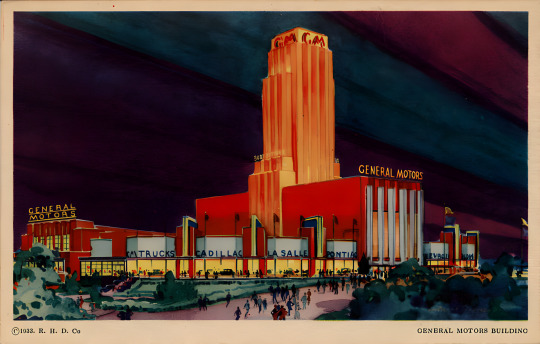
General Motors Building
Century of Progress Fair in Chicago, USA
Unknown author, R.H.D. Co, 1933
0 notes
Text
Quali sono le città in Italia con una strada dedicata a Italo Balbo?
Quali sono le città in Italia con una strada dedicata a Italo Balbo?
Quanti conoscono Italba piccola frazione dei comuni di Codigoro e di Mesola nel ferrarese? Quasi nessuno.Piccola località dell’agro bonificato codigorese-mesolano sorse nel 1936. Inizialmente conosciuta come “al cuch” (il cuculo) venne poi intitolata alla memoria di Italo Balbo dopo il tragico incidente del 28 giungo 1940 nei cieli di Tobruk. Come avvenne in Libia per la Litoranea che divenne…

View On WordPress
#Balbo avenue#Balbo drive#Balbo Monument#Century of Progress#chicago#crociera decennale#Italba#italo balbo#Regia Aeronautica#Via Balbo
1 note
·
View note
Text

They say that a perfect book title doesn't exist
0 notes
Text
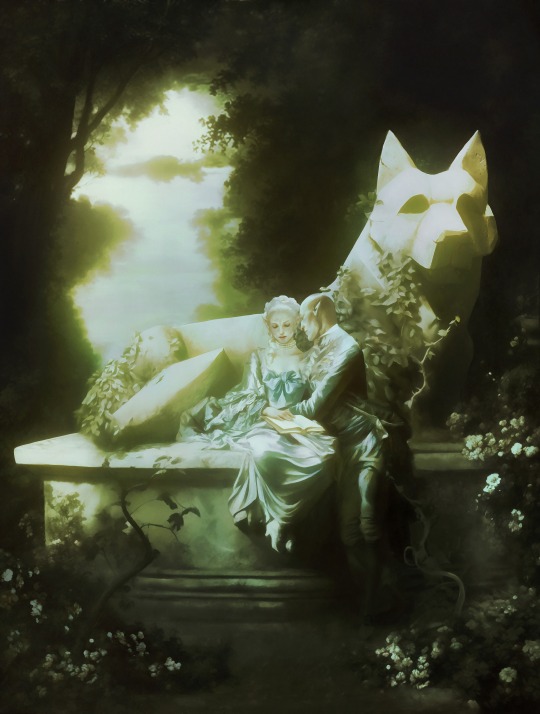
"In depth of his bewitching I felt secure and warm – I was in flowing haze that is muslin's and mistful milk of skies, and it rocked gently all my cells, and I flew into him as fallen drop, and it was weaved and volant kind of mutabors."
There is no tone of gratefulness and of adore that could suffice and form the shades that I behold to beauty that's demure and delicate and dulcet so, the one that came from @tmxpvksl and glory of their talents and abodes<зз
#digital art#original character#other's oc#semi-historical#historical portrait#fantasy#Inquisitor Lavellan#Liyanna Lavellan#Solas#dragon age#dragon age inquisition#dai#solavellan#the progress of love - love letters#by#jean honoré fragonard#was our abode to tone<зззз#rococo#18th century art
1K notes
·
View notes
Text
People declaring the Pope should excommunicate Joe Biden for genocide has me like??? Bro...what do you think the Catholic Church was built on...
#Pope Francis did call for a ceasefire and actually used the word ''cease'' even if he used waffly both-sides language#he's also been pretty progressive about recognizing and apologizing for the church's role#in the Canadian First Nation's and Rwandan genocides#but that's still bare minimum#and there was that whole deal with the Catholic Church helping save Jews in the Holocaust#but trying to help the people you helped victimize in the first place shouldn't be counted IMO#certainly doesn't erase centuries of Jewish persecution#xtianty#colonialism#Spanish colonialism#Portuguese colonialism#genocide#genocide Joe#free palestine#knee of huss
274 notes
·
View notes
Text
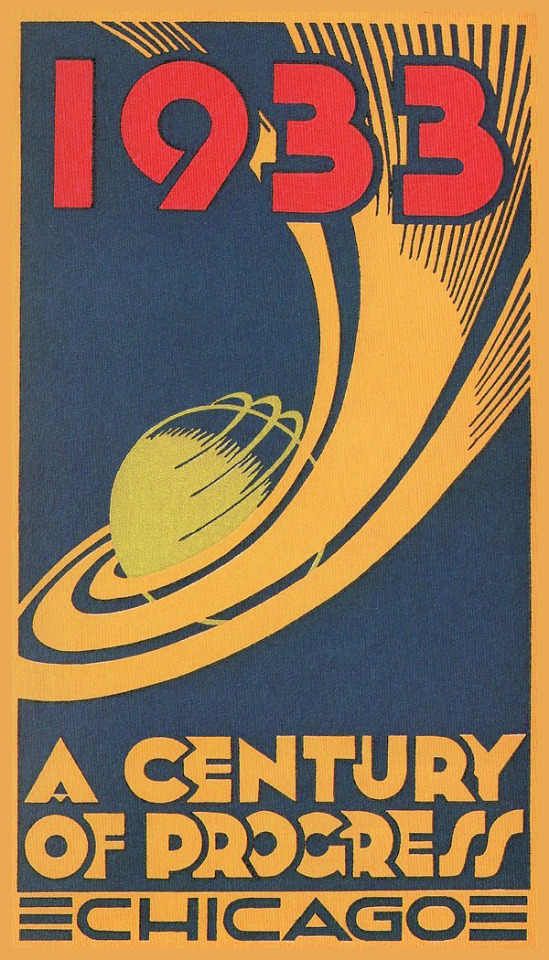
Poster for A Century of Progress International Exposition (the Chicago World’s Fair) - 1933.
#vintage posters#poster design#the 30s#art deco#chicago world’s fair#world’s fairs#century of progress international exposition#international expositions
329 notes
·
View notes
Text
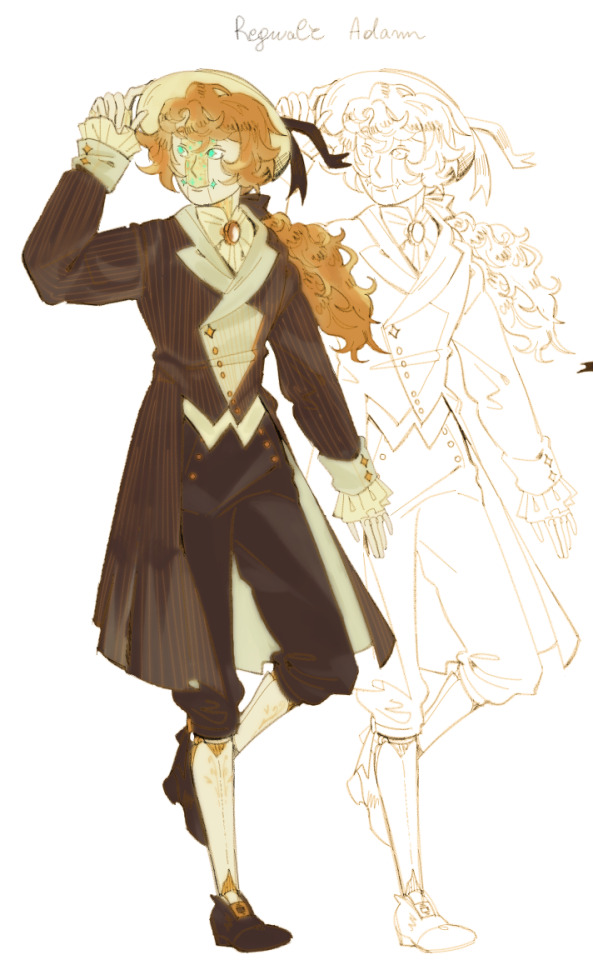
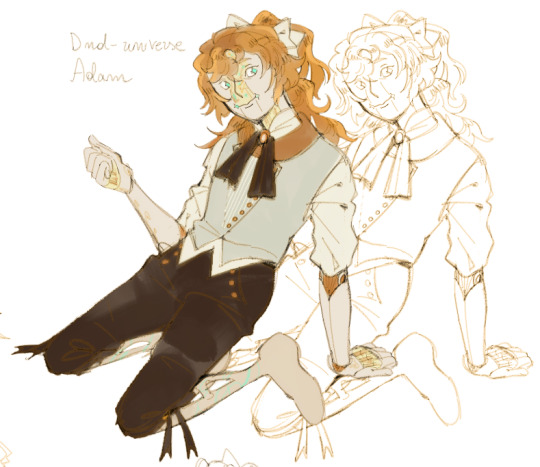
robots
#[.art]#[.oc]#Adam#dnd#automaton#android#he is a bit like a dress-up doll to me. I keep making his outfits fancier and fancier the more I look into 18th/19th century fashion#I'm glad of how my artstyle has evolved since the first time I drew Adam because I feel like he's well-suited for this kind of drawing.#1700s automaton boy in his historically inaccurate clothing. He's so special to me. In his non-dnd version he's so passive agressive#in dnd too to be fair. But at least in dnd he's gotten less attatched to the idea of his government being absolutely perfect#character development: the robot built to praise and impersonificate the city of progress is no longer a fan of the city of progress.#he's still very much a lawful-aligned character but so is almost every character I make.
262 notes
·
View notes
Text
on the first day of the parish boy’s progress, i wanted to share the victorian web with everyone joining in. it’s a really great resource, whether you’re new or new-ish to victorian lit and want a better understanding of the big picture for some of the issues charlie d. is tackling, or whether you’re familiar but want to *really* get in the weeds on the poor laws or london’s criminal underworld.
(also, fun fact, if you want to get nitpicky and pedantic, oliver twist is *technically* only a victorian novel once we hit chapter 9! the first eight chapters were published squarely in the reign of william iv, but *he* doesn't have an Era. so.)
#the parish boy’s progress#;oliver twist.#;the long nineteenth century.#;they who call the whole world brother.
64 notes
·
View notes